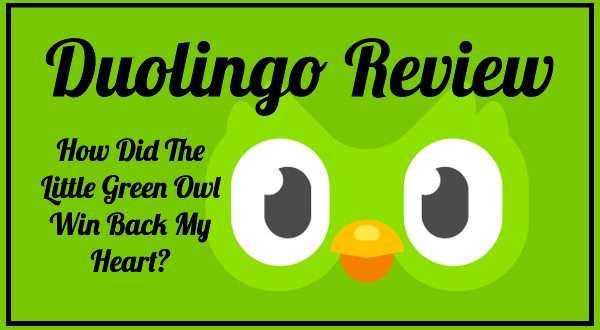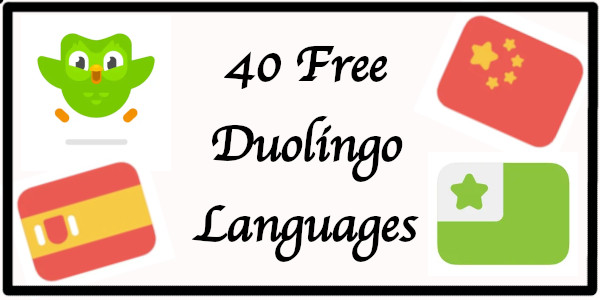Many language learners say they struggle to find dedicated time for language study. Balancing work, family, and social commitments leaves you with little room for traditional language classes or extensive study sessions.
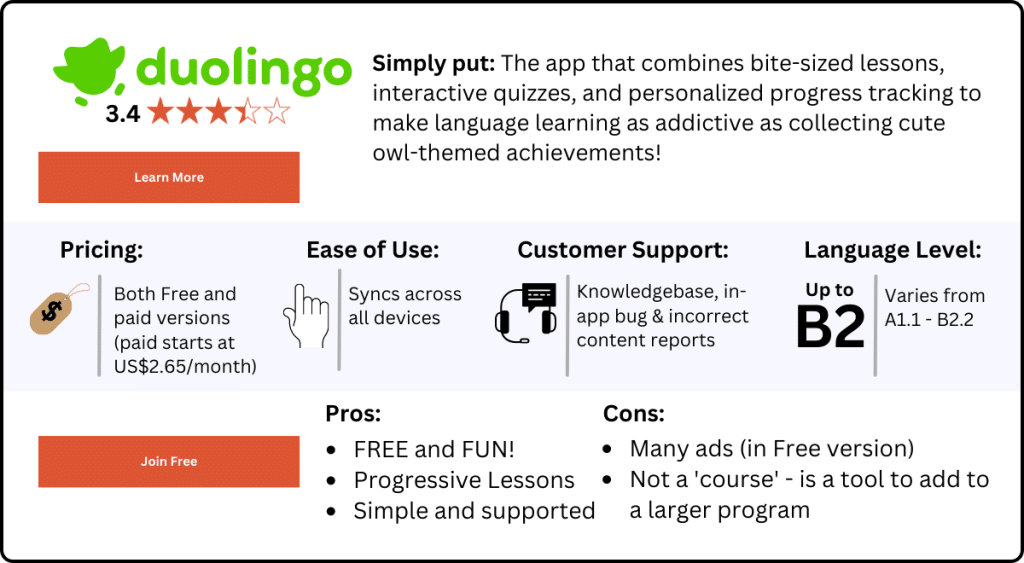
So you decide to download an app to leverage those short periods of time you have on your commute, in queues, or on a break.
But then your next problem: which app should you use? One of the most commonly tried apps today is Duolingo.
This in-depth Duolingo review is your ultimate solution to the time constraints and truth-seeking dilemma.
We clarify the key points of using Duolingo so you quickly get a comprehensive understanding of its effectiveness and time-saving features.
Discover how Duolingo optimizes your language learning experience, providing a convenient and flexible solution that fits seamlessly into your busy schedule.
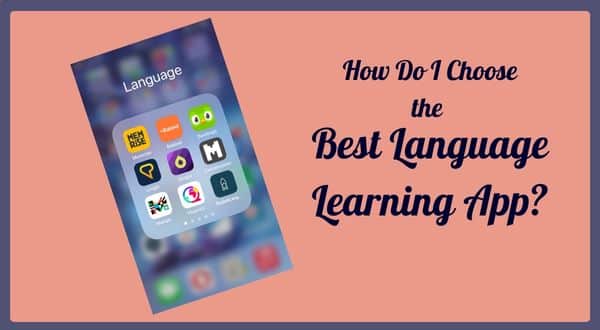
Choosing the best language app shouldn’t be a challenge. Our guide to selecting language apps will set you on the right course.
With this review as your guide, you can confidently make an informed decision and embark on a language learning journey that aligns with your goals and maximizes your precious time.
I left – and returned
In 2021 Duolingo made changes to their learning pathway that drove me away.
The motivating golden trees were replaced with a crown system that required five redundant repetitions of the same lesson to achieve the gold crown.
They also removed the ‘tree’ structure that gave choices about which topic to study next, and made it a ‘path’ that had to be followed step-by-step. Each new lesson is unlocked by completing the previous step.
Instead of motivation to complete a lesson, move on, then come back to review and upgrade past lessons to make them gold again, language learners had to do the lesson five times to get the lovely golden colour on their gameboard. (I admit it – the Dopamine rush of achieving ‘gold’ in a mere five minutes just shrivelled up and died!)
However, in 2023 Duolingo has made a further upgrade, and – now I like it again!
The ‘learning path’ is still there. But instead of repeating the same content five times, the content seems to have been made richer, and then divided into several related, but not identical lessons for each step of the journey.
Also, more efforts are being made to align the content to the Common European Framework of Reference for Languages (CEFR). As I have language requirements for my residency in France, it’s handy to know I’m working on things that will help me.
Looking for something a little more structured for your online language learning?
- 1. What is Duolingo?
- 2. Is Duolingo Good to Learn a Language?
- 3. How Many Languages Does Duolingo Have?
- 4. How Does Duolingo Work?
- 5. How Long Does It Take To Learn A New Language On Duolingo?
- 6. Does Duolingo Have A Community?
- 7. Can I Use Duolingo Offline?
- 8. How Much Does Duolingo Cost?
- 9. Customer Support & Updates
- 10. User Reviews & Ratings
- 11. Conclusion
1. What is Duolingo?
Duolingo at a glance:
| Feature | Description |
|---|---|
| Languages Offered (from English) | Arabic (Modern Standard), Chinese (Mandarin), Czech, Danish, Dutch, Esperanto, Finnish, French, German, Greek, Haitian Creole, Hawaiian, Hebrew, High Valyrian, Hindi, Hungarian, Indonesian, Irish, Italian, Japanese, Klingon, Korean, Latin, Navajo, Norwegian (Bokmål), Polish, Portuguese (Brazilian), Romanian, Russian, Scottish Gaelic, Spanish, Swahili, Swedish, Turkish, Ukrainian, Vietnamese, Welsh, Yiddish, Zulu |
| User Interface | Clean, fun and simple |
| Lesson Content | Bite-sized sessions, progressive and logical. Amount of content varies according to language. |
| Types of Exercises | Match written word with picture and/or spoken word. Cloze. Translation. Matching written and spoken words. Speaking answers. |
| Progress Tracking | Shown as a path, clear and simple. |
| Personalisation | No real personalisation, although you can test out of a topic to progress to the next. |
| Pronunciation Support | Present, but inaccurate. Many false positives and negatives. |
| Offline Access | Unclear – possibly paid version. |
| Cultural Insights | Not many. It’s difficult to know what is a cultural insight, and what is Duolingo being silly. |
| Customer Support | The app just works. So customer support is rarely required. |
| Price & Subscription | All languages free with ads. Super Duolingo from US$6.99/month; Family Duolingo from US$2.38/month; Duolingo Max: From US$14/month* |
| Available Platforms | Android, iPhone, Web Browsers |
*Currently for French and Spanish courses only, in Australia, Canada, Ireland, New Zealand, United Kingdom, United States
Duolingo is a renowned language learning app that has captured the hearts of millions worldwide.
Duolingo’s secret lies in its gamified approach, transforming language learning into an addictive and rewarding experience.
With its vibrant and intuitive interface, Duolingo offers a visually appealing learning environment that keeps users engaged and motivated.
In the context of a Duolingo review, it’s worth noting that the app’s gamification elements, such as earning points, leveling up, and competing with friends, add an exciting twist to the learning process.
By making learning feel like a game, Duolingo sparks a sense of competitiveness and accomplishment, making you eager to progress and reach fluency faster.
Furthermore, Duolingo offers a variety of exercises tailored to different language skills.
From vocabulary building to grammar drills, the app covers all the essential components of language learning.
The interactive exercises, audio clips, and real-life examples are available for Android and Apple devices, as well as online, and provide a fun learning experience that uses both real-world conversations as well as fantastical ones to teach language that sticks.
Duolingo uses an ‘implicit’ method of learning, meaning that unless you go deep into their supplementary guidebooks, the grammar is not explicitly explained.
The assumption is that you will learn it through exposure.
However, if you are coming from a language like English (that no longer uses a case system for most of the language), you may encounter many grammatical features that may be confusing without explicit teaching.
2. Is Duolingo Good to Learn a Language?
Duolingo has amassed a dedicated community of language learners who rave about its effectiveness and entertainment value.
Many users have reported improved speaking, reading, and writing skills, crediting Duolingo’s bite-sized lessons and engaging content for their progress.
Duolingo’s courses, particularly it’s Spanish course, have been the subject of academic research, and it has been shown in particular to be effective in helping language learners improve reading and listening skills for a language.

While Duolingo courses do have an AI speech recognition facility to check your spoken language skills, and writing tasks within the units, there does not seem to be a lot of research supporting these tasks as being terribly helpful in language production skills.
It doesn’t mean that the app doesn’t teach them, simply that in order to produce a language, a great deal of practise is required; much more than producing a word or short phrase in answer to a short question.
A multitude of Duolingo meme’s do the rounds, discussing the silliness of the sentences that Duolingo has you learn.
This is done deliberately; research indicates that people remember silly and unusual sentences, and Duolingo leverages this by having users learn such nonsense as ‘I am crying and the onion is laughing.’
Before I understood the reasoning, this sort of lesson annoyed me because I felt I was learning useless vocabulary.
But having learned the idea behind it, and particularly for those courses that have since been aligned with CEFR/ACTFL frameworks, I have more confidence that the vocabulary and grammar is helpful, and I can see the point in presenting the content in a fun manner.
Duolingo focuses on building vocabulary and grammar skills through short exercises and repetition.
While the app provides some listening and speaking practice through audio exercises, the main emphasis is on reading and writing skills.
Overall, Duolingo takes a well-rounded approach to language learning, but places more weight on vocabulary and grammar drills compared to speaking and conversation.
The app uses primarily an ‘implicit learning through exposure’ approach for grammar, and as such some language learners might feel they miss essential points.
An attempt is made to balance the gamified lessons by providing explicit grammar information in the ‘Guidebook’ for each unit.
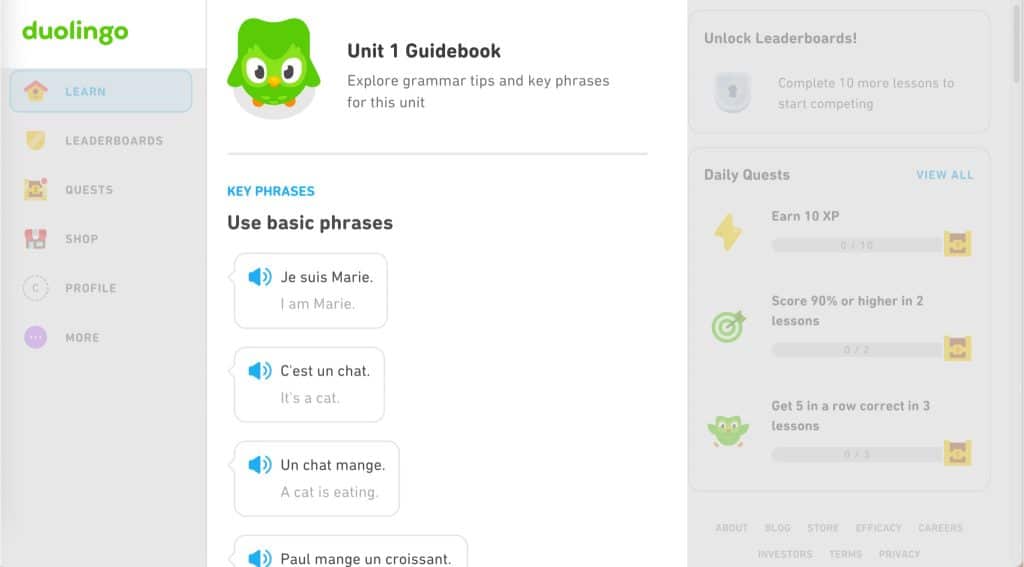
Duolingo’s approach of gamifying vocabulary and grammar lessons through short interactive exercises makes it engaging and a fun way to introduce learners to a new language.
However, the lack of personalized feedback, guidance from language experts, and opportunities for spoken interaction with native speakers limits how much users can improve their listening, speaking and fluency beyond beginner levels.
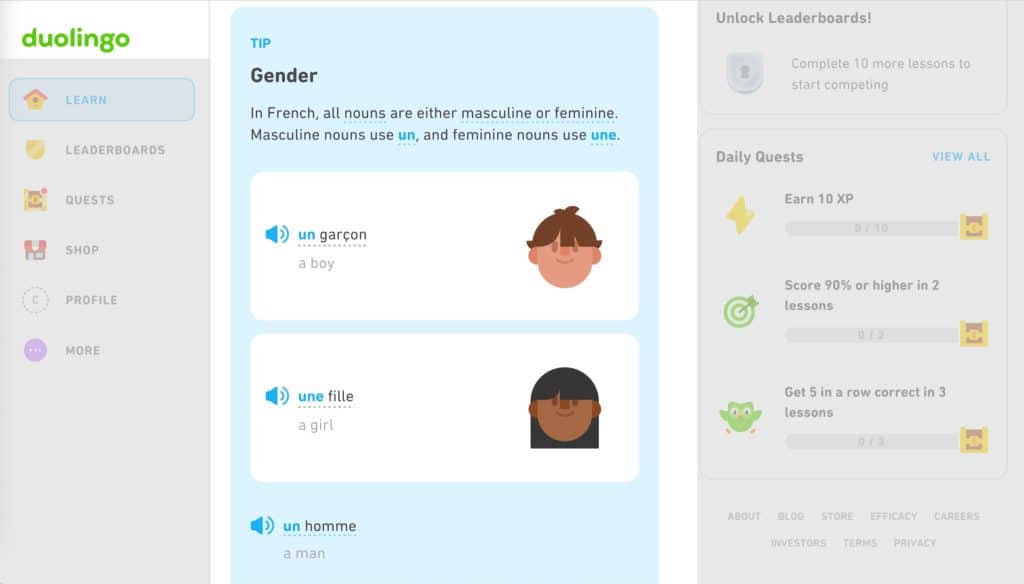
Duolingo can be good for getting the basics and fundamentals of a language.
But for more advanced skills and proficiency, learners will need to supplement Duolingo with other resources that offer personalized instruction, conversation practice, and immersion opportunities.
Overall, Duolingo is most effective for initial exposure and getting started with a new language, and it is also useful for revision.
In most languages, other methods are needed for making significant progress beyond beginner levels.
It is probably possible to achieve at least a solid B1 in French, Spanish, German and English if you learn all the information presented in the extra notes and guides.
3. How Many Languages Does Duolingo Have?
At time of writing this Duolingo Review (October, 2023), Duolingo has you covered with 39 languages to learn from English, including conlangs Esperanto, High Valyrian and Klingon (yes, seriously!).
In addition, you can learn Catalan from Spanish, and English from 24 other languages.
This expansive language selection ensures that learners of a variety backgrounds and interests can find their ideal language to conquer.
For an in-depth look at all the available Duolingo languages, including how comprehensive they are, how standardised with CEFR frameworks, & which can be learned from languages other than English, check out ‘Unlocking 40 Duolingo Languages: What Hidden Gems Can You Learn For Free Today ‘
4. How Does Duolingo Work?
Since our Duolingo Review in 2022, Duolingo has changed to a defined path for learning.
Previously they used a system a little like Babbel, where you can choose which themed unit you want to learn. And if you hadn’t covered particular vocabulary for a while, the app would show you by a ‘crack’ appearing in the gold crown,
Now lessons are defined, and repetition is built into the path. You can review past lessons (normal review for free to win +5 XP, Legendary review for 100 gems to win +40 XP), and do timed reviews for 100 gems to win +40 XP).
The first step of the new themed lesson is revision of previous lessons, and there are rewards along the path during the lesson.
If the content is not new for you, you can test out at any stage. The lessons seem to progress faster and are more interesting.
And if you are learning Spanish, French or some of the more popular languages, there is an extra benefit in that they have now been aligned with the CEFR/ACTFL language proficiency paradigms, which means you can get a clear idea about your language level.
A. Learning Content
A.1 Content Quality & Diversity
The content of Duolingo comes from a combination of user-generated content and expert curation.
At the time of our previous Duolingo Review, Duolingo used teams of volunteers to create some courses – hence the inclusion of the mini-course in Navajo and others.
Now they are keeping content creation in-house. The content creators are educators, linguists, curriculum experts and language learners, expert in their fields.
As with all things public, Duolingo receives its fair share of criticism, and the nonsensical type of content has been one of the things frequently criticised.
However, Duolingo has stated that it deliberately creates content that is nonsensical as a method of making it memorable.
More recently the company has been curating the various courses’ contents and aligning them with CEFR/ACTFL language proficiency frameworks.
This improves its legitimacy in the language education market, and has helped Duolingo become usable in schools and universities as a complementary tool.
User feedback and contributions are carefully reviewed by a team of language experts to maintain accuracy and relevance, ensuring that the learning materials meet the highest standards.
Duolingo has been using AI for some time in the app with its voice recognition tasks. More recently it made a statement regarding its use of AI to help generate exercises, and how they are quality checked by humans.
A.2 Types of Exercises
Translation Tasks
The Duolingo translation tasks involve translating sentences from the target language into English and vice versa.
Sometimes you will be given the words in tiles to choose from, but as you advance you will have to type the words into the answer section in full.
Accents and special characters can be selected from a special keypad if your computer or phone don’t have them.
Listening Exercises
In the listening exercises you will listen to an audio clip and select the word from a group of tiles, or transcribe or speak what you hear, rather than being asked to translate the content.
NOTE: The speaking answers rely on voice recognition for correction, and it is often quite faulty. It may absolutely not accept your answer, or may accept an incorrect answer.
During the course of writing this Duolingo Revew, I tested it to see if it will accept a wrong word, word in a different language, and a really poorly spoken correct answer, and I was able to make it accept all three.
To increase the challenge and engagement, I recommend attempting to mentally translate the sentence before typing your response.
Once you submit your answer, you will find the translation at the bottom of the screen to check your accuracy.
Multiple Choice Questions
As you would expect, with multiple choice questions you are given a sentence in English and asked to select the correct meaning in your target language (or vice-versa) from a list of options.
Cloze Questions
Cloze tasks are those where a word is missing from a sentence and you must select the word that makes the most sense to complete it from a list of options.
The cloze tasks in Duolingo begin with as many answers as there are blank spaces. As the level of language increases, more answers than questions are given, so you need to have a better understanding of the options.
Pairing Tasks
You are given up to ten words and must match the target language with the English translation.
A.3 Proficiency Levels Covered
Duolingo courses teach to varying levels of language proficiency, depending on the language. Spanish, French and German (taught from English) are taught and aligned to CEFR/ACTFL frameworks.
There are a few other courses that teach to a B1 or B2 level, but the majority of languages are really only introducing you to a beginner level of language skills. Of those, many are somewhat haphazard in the content included. It has been difficult to find Duolingo Reviews of specific languages that I haven’t yet tested to know more precisely.
B. Features
B.1 Key Features of Duolingo
Duolingo is a widely used language learning application that has gained immense popularity worldwide. It is known for its effectiveness in making language learning an enjoyable experience, which has been supported by research findings.
The app offers a wide range of language courses, encompassing popular languages such as Spanish, French, German, Italian, Portuguese, Russian, Japanese, and several more obscure languages, including some conlangs.
Each language course is divided into skills, with each skill comprising five levels of lessons.
Duolingo employs various teaching methods, including listening, speaking, reading, and writing exercises, catering to different learning styles.
The app provides a diverse set of exercises, such as translation, multiple choice, and fill-in-the-blank, to reinforce language skills.
Additionally, Duolingo offers helpful features like chatbots, stories, and podcasts to further assist users in their language learning journey.
While a free version of the app is available, Duolingo also offers a premium option called Super Duolingo, which grants users additional benefits like an ad-free experience, offline access, and unlimited ‘hearts’ (lives).
B.2 Gamification & Engagement
To enhance user engagement, Duolingo incorporates gamification elements like streaks, badges, and leaderboards called ‘Leagues’.
Streak:
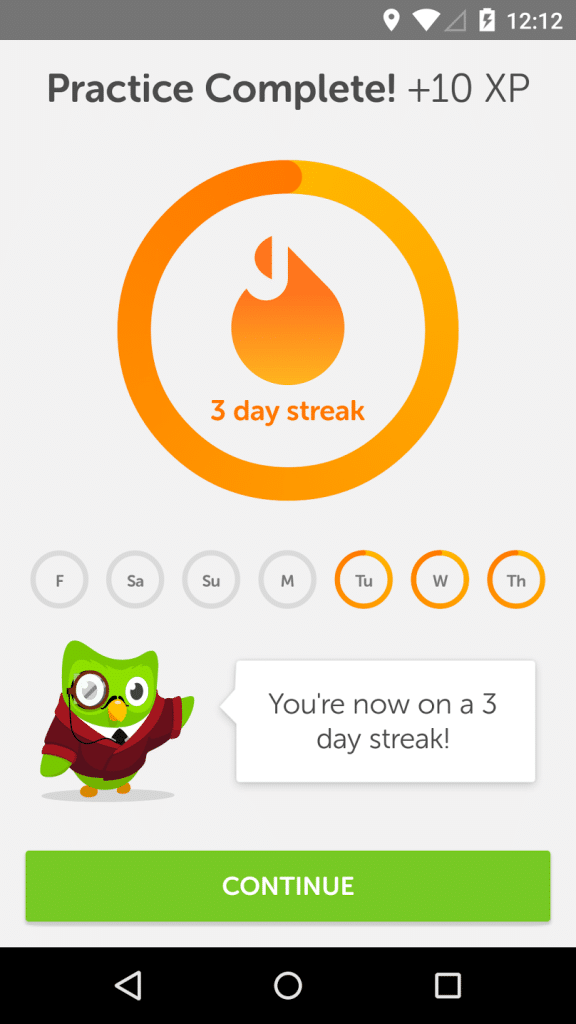
A ‘streak’ in Duolingo refers to the consecutive days a user engages with the app by completing lessons or activities.
Maintaining a streak encourages consistent learning and is visually represented by the number of days in a row a user has actively participated in the platform.
Badges:
Badges in Duolingo are earned as a recognition of your achievements and milestones in language learning.
By completing various lessons, exercises, and challenges, you unlock different badges that signify your progress, dedication, and accomplishments on the platform.
These badges are displayed on your profile, allowing you to showcase your language learning journey and accomplishments to others.
Leagues:
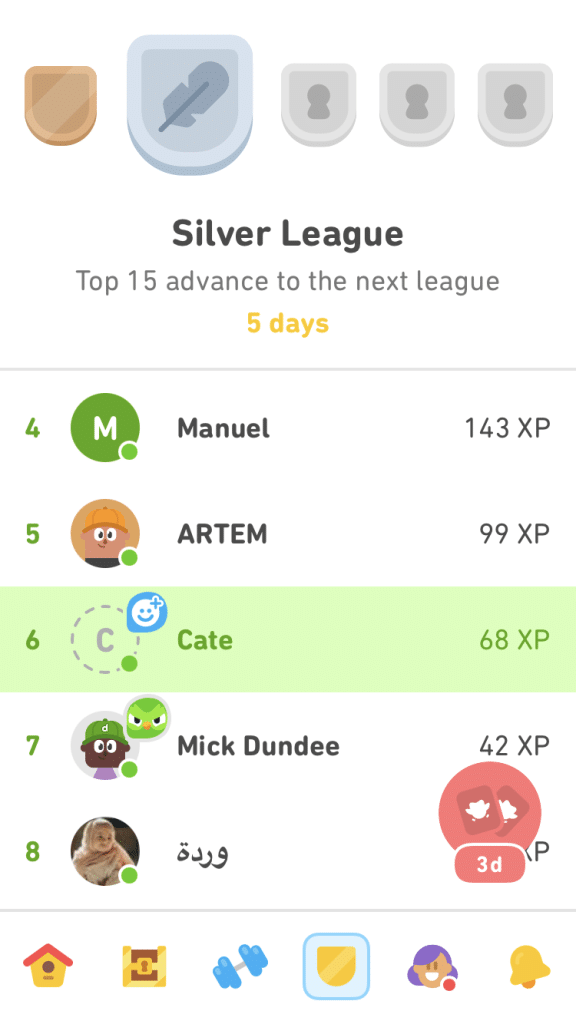
Duolingo Leagues are competitive ranking systems that allow users to compare their progress with other learners around the world.
Users are grouped into leagues based on their skill level and learning activity.
As you complete lessons and challenges, you earn points that contribute to your league ranking, promoting a sense of friendly competition and motivation to consistently engage with the app.
At the end of each week, learners may be promoted to higher leagues or receive rewards based on their performance, encouraging continued language learning efforts.
Gems:
One unique aspect of Duolingo’s structure is the concept of “gems.”
At the time of my previous Duolingo Review, there was very little that gems could be used for.
Gems can be earned by completing lessons, achieving daily goals, or maintaining streaks of consecutive days of learning.
With the updates, these gems now truly serve as a virtual currency within the app, and can be used to unlock various features, such as additional lessons, practice exercises, legendary practices, and even time extensions for certain activities.
B.3 Personalization & Adaptiveness
The Duolingo app ensures personalized learning by tailoring lessons to the user’s individual strengths and weaknesses as they progress through the course. According to a whitepaper Duolingo published in January 2023,
“Duolingo meets learners where they are and leverages their own responses and in-app behaviors to help them improve. From providing more practice where learners need it, to adjusting exercise order and difficulty, to providing feedback based on learner responses, we personalize the learning environment to boost learners’ growth and long-term knowledge.”
C. Freeman, A. Kittredge, H. Wilson & B. Pajak, ‘The Duolingo Method for App-based Teaching and Learning Duolingo Research Report‘, January 11, 2023,
(https://bit.ly/duolingo-method-whitepaper-pdf last accessed 29 August, 2023).
Duolingo uses well-established research into memorisation, in combination with assessments of each learner’s progress, to tweak what reviews you are given and at what timing. This results in Duolingo users retaining what they have learned more effectively.
B.4 Language Testing
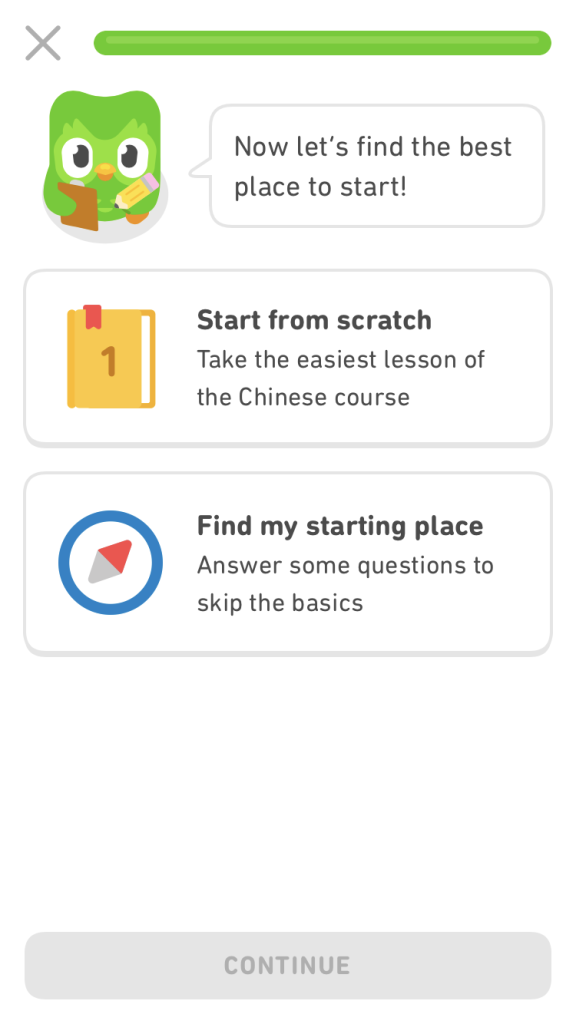
Duolingo offers every user a free placement test for every language as you start the course. Alternatively, you can just choose to start at the beginning.
If at any time you feel the course is too easy, or is covering knowledge you already have, by clicking on “Jump Here” you can test ahead.
The tests are reasonably rigorous, and in any case the content will be reviewed in future steps.
Official English Certification
In addition, since our last Duoingo Review, the company has introduced an official ‘English Certification’ test, which is of sufficient rigour that it is being accepted by several thousand universities and places of higher education.
It is also accepted for student visa applications for USA and Ireland. The test is completely online, making it very convenient for students outside of traditional TOEFL/TEFL testing areas.
The cost of the English certification is US$59 per test. It is possible to complete practice tests before attempting the real thing.
B.5 Extra Material
Free Podcasts:
Podcasts (with transcripts) are available on Apple Music, Google and Spotify, for French and Spanish from English, and English from Spanish and Portuguese.
Stories:
Stories had their own tab, and were easily accessed when we published our last Duolingo Review. Now they are interspersed through the learning path.
However, if you have Super Duolingo, it is available as a feature under an extra ‘Practice’ tab.
5. How Long Does It Take To Learn A New Language On Duolingo?
If you spend 1 hour and 50 minutes a day, seven days a week learning languages on Duolingo, the length of time it will take you to learn a new language is around twelve months.
How do I figure that?
Most language schools say it will take 600-650 hours of study to achieve an B2 level of language.
B2 is the level of language I have found gives me the amount of vocabulary, grammar and conversational practise to feel like I am able to communicate relatively fluently. And to a place where I will not forget it.
Divide 650 hours by 365 days, and you have 1:50 hours of Duolingo lessons to achieve a conversational fluency.
If you were to do one hour per day, which seems a little more do-able, it would likely take you two years to achieve a B2 level.
And that is assuming that Duolingo teaches your language to a B2 level – remember, it only teaches French and Spanish to that level.
It should also be said that Duolingo is a great vocab learning app – but you will learn faster, and have a more rounded experience if you use other resources in your language learning journey.
So let’s be clear… if all you do is five minutes a day of Duolingo, you are not going to be speaking ANY new language, anytime soon!
6. Does Duolingo Have A Community?
There is no longer an official Duolingo forum or community, but there is the ability to follow and connect with friends on Duolingo, and the Duolingo Leagues also create the potential to build community. Interaction is only on a one-to-one basis of course.
However, in the course of researching this Duolingo Review, I discovered there are a number of unofficial Duolingo communities where learners can connect and share their language learning journey, which adds an extra layer of motivation and encouragement.
- Duolingo Discord community with over 35k participants
- Duolingo Reddit community with over 200k participants
- Duolingo Fandom Wiki if you are interested in participating in documenting the Duolingo experience.
7. Can I Use Duolingo Offline?
All progress is synchronized across devices, allowing users to seamlessly switch between platforms. This is also the case for progress made offline. The next time you are online, everything will sync up.
Unfortunately, Duolingo is available offline only if you have started a lesson before going offline. In addition, only that lesson will be available offline.
For users in areas with reliable internet connections or 4G+ mobile (cell) phone networks, this is rarely a concern.
However, if you want to use Duolingo in an area where there are intermittant connections or a lack of mobile access, it can be quite frustrating when the app stops working.
8. How Much Does Duolingo Cost?
Duolingo is a ‘Freemium’ product, with free access to the ad-supported courses, and in-app purchases available to eliminate advertisements (‘Super Duolingo’), upgrade to family packs, and purchase ‘Duolingo Max’.
A. Is Duolingo Free?
All languages are available to learn free, with
- no time limit,
- no limit to the number of languages you can learn at the same time, and
- no usage limit, apart from the ‘hearts’ system (which operate like ‘lives’ in a game), in which every mistake will cost you a heart.
B. How Much is Super Duolingo (known as Duolingo Plus*)?
Paying for the Super Duolingo subscription means you have no ads, unlimited hearts/lives, mistakes reviews, unlimited legendary challenges, access to extra practice exercises like stories.
Super Duolingo Package:
1 Month: US$12.99/month
12 Months: US$83.99 (US$6.99/month, billed annually)
*At the time of our previous Duolingo Review, this was known as ‘Duolingo Plus’, and I still see many people asking about it under that name. I hope this review clarifies the issue.
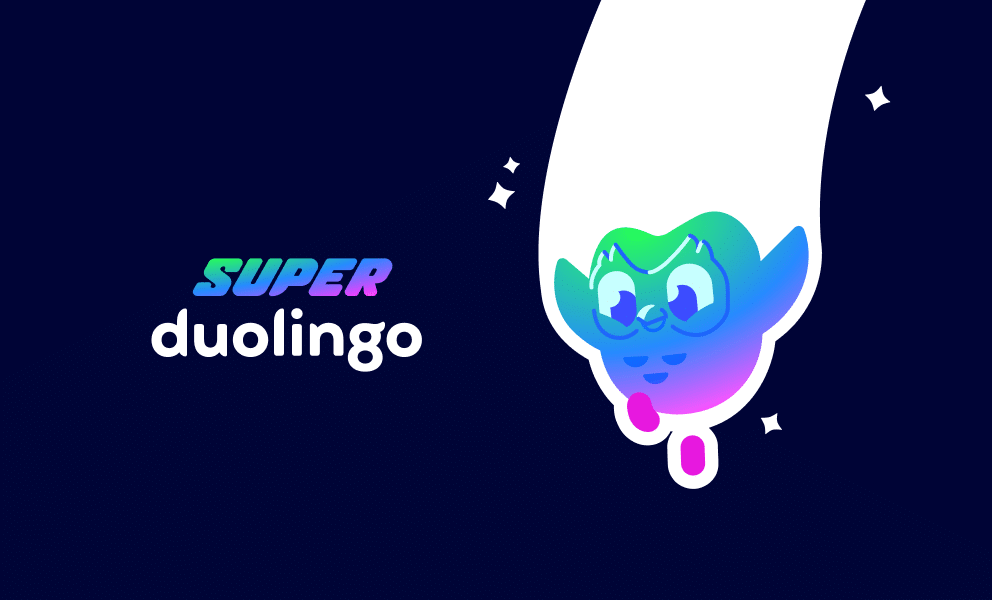
C. How Much is the Family Duolingo Package?
The Family Duolingo Package costs US$199.99 billed annually (from US$2.38/month/user) and is a great way to give the whole family access to an ad-free Duolingo experience. It allows Super Duolingo accounts for up to 7 users.
Family Duolingo Package:
12 months: US$199.99 billed annually
D. How Much is the Duolingo Max Package?
The Duolingo Max Package costs US$29.99/month, or US$167.99/year, and is currently available for French and Spanish courses only, and only in the Australia, Canada, Ireland, New Zealand, United Kingdom, United States markets.
Duolingo Max consists of Super Duolingo + AI Roleplay + AI Explain my Answer.
Duolingo Max:
1 Month: US$29.99/month
12 Months: US$167.99 (US$14/month, billed annually)
B. Is Super Duolingo (formerly Duolingo Plus) Worth It?
Yes, Super Duolingo is worth the cost, not only to save having to see repetitive ads of the Evil Green Owl telling you to buy Super Duolingo!
I recommended paying for the app in my previous Duolingo Review, and nothing has changed with the updates. In fact, I think it is even more useful now.
The Super Duolingo subscription offers unlimited hearts/lives, mistakes reviews, and access to extra practice exercises, including stories.
Legendary challenges are also available without limitations. The subscription comes in two options: a 1-month plan for $12.99 and a 12-month plan at $83.99 ($6.99/month when billed annually).
Limitations for Free Users: While free users can access a range of features, they may encounter ads and have limited hearts/lives, which can affect the learning flow.
Additionally, access to legendary challenges and certain extra practice exercises are restricted for free users, requiring payment with ‘Gems’.
Value for Money: The Super Duolingo subscription offers a comprehensive package for learners seeking an uninterrupted and enriched experience.
With an array of benefits, including no ads, unlimited resources, and expanded practice exercises, the pricing model provides considerable value for learners committed to consistent and immersive language learning.
The choice between the monthly and annual plans allows users to select the option that aligns with their learning goals and budget, making the Super Duolingo subscription an appealing investment for those dedicated to maximizing their language acquisition journey.
9. Customer Support & Updates
A. Availability & Responsiveness of Customer Support
No Duolingo Review would be complete without addressing the customer support situation.
As with most apps and online programs, Duolingo’s Customer Support is entirely online.
In the first instance, there is a Help page where you can check out the FAQ pages and other common issues.
If your issue is not addressed there, you can submit a support request, although the alternatives to categorise your issue may not fit. There is no ‘other’ … only ‘other bug’. (I would NOT suggest you use this one, or any other bug reports, as the automated response includes the statement ‘Please note that you are not likely to get a personal reply to this message.’)
You should receive an automated response immediately in your email inbox. If you don’t … go searching in Spam, so that when they DO respond, you get the email.
In addition to adding your own Duolingo Review in either of the app store platforms, it is also possible to report an issue in the iPhone App Store, or Google Play Store for Android.
Nevertheless, it is rare to need to contact Duolingo. Their app is very stable, and updates occur regularly every week with bug fixes.
B. Content Updates, Features, & Bug Fixes
The content itself, and in fact the whole duolingo experience, is constantly being A/B tested, so it is not uncommon for two people to have slightly different experiences.
In addition, big updates are usually rolled out progressively across different countries, and in different languages.
10. User Reviews & Ratings
The Duolingo review in the iPhone App Store has a very high 4.7 star rating , and has been voted the No. 1 app in the Education section of App Store. It has 4.6 stars in Android’s Google Play Store, where it has been downloaded over 100 million times.
As with many apps, Duolingo has it’s share of detractors, but the majority of the MILLIONS of reviews it has are positive.
The most common complaints are people getting sick of seeing the ads (to which I say “buy the upgrade”!), and people not liking the major update that happened a year or so ago.
11. Conclusion
All in all, Duolingo has done something right to achieve their No. 1 place in language learning apps – and that something is probably choosing to be FREE! The fact that they also have such a wide array of languages helps too.
The clean, fun interface, and even the obnoxious Green Owl, have all resulted in an app with a personality. The team has done well to create an identity, and consequent Cult-type following, that has millions of people learning languages.
So, because of the research I had to do for this Duolingo Review post, I am back to using Duolingo. Not compulsively, and certainly not in isolation. But it is aiding in my pursuit of languages.
Try it! See if you get addicted to the little Green Owl too!
Cate is a language enthusiast sharing her language learning journey here. Apart from her native English (albeit 'Strine'*!), as an adult she has also learned Auslan (Australian Sign Language) to approximately a C1 level, Dutch to around B1/2, French to around A2, and has a smattering of other languages.
B.A. (Anthropology/Marketing), Grad. Dip. Arts (Linguistics), Grad. Cert. Entrepreneurship & Venture Development, (CELTA).
Auslan Interpreter (NAATI), and general Language Nut.
*For more information on 'Strine', visit https://en.wikipedia.org/wiki/Strine

